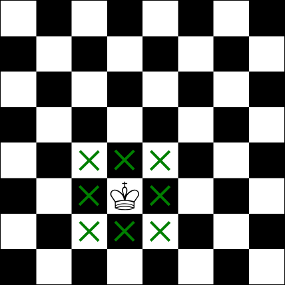Chess has six types of pieces: the Pawn, Rook, Knight, Bishop, Queen and King. Each piece has its own unique way to move. There are some similarities between the moves of the various pieces. All the pieces except the knight move in a straight line - horizontally, vertically or diagonally. They cannot move past the end of the board and return on the other side. The edge of the board is a boundary which cannot be crossed. All the pieces except the knight may not jump over other pieces - all squares between the square where the piece starts its move and where it ends its move must be empty. The move may not end on a square presently occupied by a piece of the same color.
If the square where a piece ends its move contains an opponent's piece, the opponent's piece is “captured”, and it is removed from play. All the pieces may be captured except the king. The game ends on the move before the king is captured - “checkmate”. Capturing always requires the attacking piece to land on the square of the opponent's piece while making a normal move. The only exception is for capturing a pawn en passant. You are not required to capture a piece when there is an opportunity to do so, capturing is an option. The only time that capture is required is if the king is under attack and capturing the attacking piece is the only way to stop the attack.
In the picture below, the white rook can move to the right, left, up or down (vertically or horizontally) in straight lines. It can move down and to the right any number of squares until the end of the board is reached. These squares have a green X on them. It can move a maximum of two squares to the left. The remainder of the board is blocked by a piece of the same color, in this case a white knight. The rook cannot jump over the knight to reach the end of the board. It can move only one square up before being blocked by the black pawn. It can capture the pawn by moving two squares up and landing on the pawn, since the pawn is an opposing piece (piece of a different color). This square has a red X on it. It cannot jump over the pawn to reach the end of the board. Therefore, the rook has a total of ten squares where it can go.
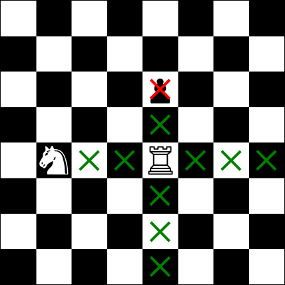
To begin the game, white moves first. The players then alternate making one move at a time. You must move on your turn, you are not allowed to pass.
The pawn is the most numerous and the least powerful piece on the chessboard. Pawns are unusual in their movement. Generally the pawn moves forward only, one square at a time. An exception is the first time a pawn is moved, it may move forward two squares. The pawn cannot jump over other pieces; any piece directly in front of a pawn blocks its advance to that square. The pawn is the only piece that cannot move backward. The pawn is also the only piece that does not capture in the same way that it moves. The pawn captures an opposing piece by moving diagonally one square - it cannot capture by moving straight ahead.
In the picture below the lower pawn is still on its original square, so it may move one or two squares forward (indicated by the green X). It may capture by moving to the right or left at a diagonal, but only if that square is occupied by an opposing piece (indicated by the red X). Otherwise, it may not move diagonally. The upper pawn has already moved from its original square. It may move only one square forward. Likewise, it can capture moving to the left or right diagonally if the square contains an opposing piece.

The pawn also is involved in two special moves. The first is the en passant capture where a pawn is captured on its initial two square move. The second is the pawn promotion where a pawn is promoted to another piece when the pawn reaches the other end of the board.
The Bishop moves in a straight line diagonally on the board. It can move as many squares as wanted, until it meets the end of the board or another piece. The bishop cannot jump over other pieces. The bishop captures on the same path it moves, by landing on the square of the opposing piece. Because of the way the bishop moves, the piece always remains on the same color squares it started on. Each player begins with two bishops, one on the black-colored and one on the white-colored squares. They are frequently referred to as the “dark-squared” bishop and “light-squared” bishop. The bishops can also be named according to the side they begin on - king's bishop and queen's bishop.
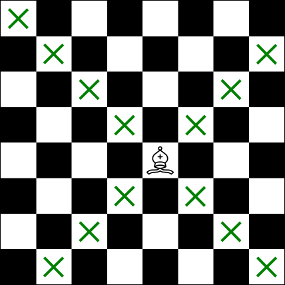
The rook moves in a straight line either horizontally or vertically through any number of unoccupied squares, until it reaches the end of board or it is blocked by another piece. It cannot jump over other pieces. The rook captures on the same path it moves, by occupying the square on which an enemy piece stands. The rook can land on any square on the board, therefore it is one of the more powerful pieces on the board.
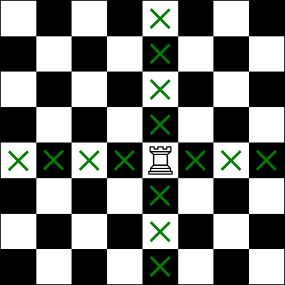
The rook is also involved in a special move. It is the castling move where a rook and the king are grouped into a defensive position.
The Knight is the most special piece in chess, having a flexibility that makes it a powerful piece. The knight is the only piece on the board that may jump over other pieces. The knight moves two squares horizontally or vertically and then one more square at a right-angle. The knight’s move is shaped as an “L”. The knight always lands on a square opposite in color from its initial square. The knight can jump over pieces of either color while going to its destination square, but it does not capture any pieces it jumps over. The knight captures by landing on the square of the opposing piece. The knight cannot land on a square occupied by a piece of the same color. Since the knight's movement is not in a straight line, it can attack a queen, bishop, or rook without being reciprocally attacked by that piece.
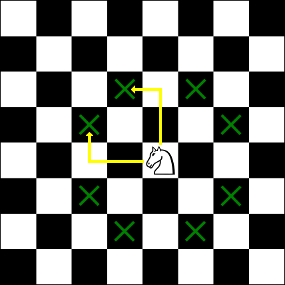
The Queen is considered the most powerful piece on the board. It can move any number of squares in a straight line - either vertically, horizontally or diagonally. The queen moves like the rook and bishop combined. Unless capturing, the queen must move to an unoccupied square; and it cannot jump over pieces. The queen captures on the same path it moves, by landing on the square of the opposing piece.
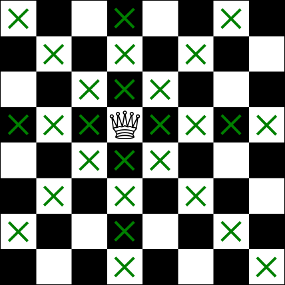
The King is the most important piece in chess. If the king is trapped so that its capture is unavoidable, the game is over and that player loses. The king has little mobility, so it is also considered one of the weakest pieces in the game. The king can move to any adjacent square. That is, it can move one square in any direction: horizontally, vertically, or diagonally. It cannot move onto a square occupied by a piece of the same color. The king captures another piece in the same way it moves, by landing on the square of the opposing piece. There is an additional limit on the movement of the king. The king may not move to a square which would put the king under attack by an opposing piece (called in “check”). As a result of this limit, two kings may never stand next to each other - since moving next to the opposing king would put the moving king into check. The king can also be forced to move or capture if the king is under attack (“check”) and the only way to stop the attack is to move the king.
